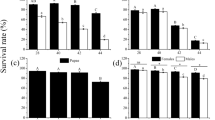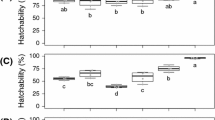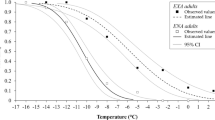Abstract
Biological control of spider mites in hot and dry weather is a serious technical issue. A high-temperature adapted strain (HTAS) of the predatory mite Neoseiulus barkeri Hughes was selected from its conventional strain (CS), via long-term heat acclimation and frequent heat hardenings in our previous studies. However, the environment of high temperature is usually associated with enhanced ultraviolet (UV) radiation. In the present study, the physiological effects of UV-B radiation on survival rate and egg damage of N. barkeri were investigated, as well as the activities and expression profiles of antioxidant enzymes to UV-B radiation stress. UV-B radiation had deleterious effects on egg hatchability and survival of N. barkeri. Adults of the HTAS strain were less UV-B resistant than those of the CS strain; they also had lower levels of enzymatic activity of superoxide dismutase (SOD) and catalase against oxidative damage and weaker upregulation of SOD genes. The mRNA expression of three SOD genes of CS adult females immediately increased whereas that of HTAS showed almost no difference under UV-B stress for 1 h. The results showed the HTAS of N. barkeri had lower fitness under UV-B stress compared with the CS of N. barkeri. These results suggested that long-term heat acclimation may exert a profound impact on the developmental physiology of N. barkeri.





Similar content being viewed by others
References
Bannister JV, Bannister WH, Rotilio G (1987) Aspects of the structure, function, and applications of superoxide-dismutase. Crit Rev Biochem 22:111–180
Bonde J (1989) Biological studies including population-growth parameters of the predatory mite Amblyseius barkeri Acarina, phytoseiidae at 25 °C in the laboratory. Entomophaga 34:275–287
Bordo D, Djinovic K, Bolognesi M (1994) Conserved patterns in the Cu/Zn superoxide-dismutase family. J Mol Biol 238:366–386
Bradford MM (1976) Rapid and sensitive method for quantitation of microgram quantities of protein utilizing principle of protein-dye binding. Anal Biochem 72:248–254
Brouwer M, Brouwer TH, Grater W, Enghild JJ, Thogersen IB (1997) The paradigm that all oxygen-respiring eukaryotes have cytosolic Cu/Zn superoxide dismutase and that Mn superoxide dismutase is localized to the mitochondria does not apply to a large group of marine arthropods. Biochemistry 36:13381–13388
Buck N, Callaghan TV (1999) The direct and indirect effects of enhanced UV-B on the moth caterpillar Epirrita autumnata. Ecol Bull 47:68–76
Cadet J, Wagner JR (2013) DNA base damage by reactive oxygen species, oxidizing agents, and UV radiation. Cold Spring Harb Perspect Biol 5:18
Caldwell MM, Bjorn LO, Bornman JF, Flint SD, Kulandaivelu G, Teramura AH, Tevini M (1998) Effects of increased solar ultraviolet radiation on terrestrial ecosystems. J Photochem Photobiol B 46:40–52
Chidawanyika F, Terblanche JS (2011) Costs and benefits of thermal acclimation for codling moth, Cydia pomonella (Lepidoptera: Tortricidae): implications for pest control and the sterile insect release programme. Evol Appl 4:534–544
Coors A, De Meester L (2008) Synergistic, antagonistic and additive effects of multiple stressors: predation threat, parasitism and pesticide exposure in Daphnia magna. J Appl Ecol 45:1820–1828
Daiber A (2010) Redox signaling (cross-talk) from and to mitochondria involves mitochondrial pores and reactive oxygen species. Biochim Biophys Acta 1797:897–906
den Hartog GJM, Haenen G, Vegt E, van der Vijgh WJF, Bast A (2003) Superoxide dismutase: the balance between prevention and induction of oxidative damage. Chem Biol Interact 145:33–39
Domonkos I, Kis M, Gombos Z, Ughy B (2013) Carotenoids, versatile components of oxygenic photosynthesis. Prog Lipid Res 52:539–561
Douki T, von Koschembahr A, Cadet J (2017) Insight in DNA repair of UV-induced pyrimidine dimers by chromatographic methods. Photochem Photobiol 93:207–215
Epp RG, Erickson DJ, Paul ND, Sulzberger B (2007) Interactive effects of solar UV radiation and climate change on biogeochemical cycling. Photochem Photobiol Sci 6:286–300
Feng YC, Liao CY, Xia WK, Jiang XZ, Shang F, Yuan GR, Wang JJ (2015) Regulation of three isoforms of SOD gene by environmental stresses in citrus red mite, Panonychus citri. Exp Appl Acarol 67:49–63
Fridovich I (1975) Superoxide dismutases. Annu Rev Biochem 44:147–159
Fukaya M, Uesugi R, Ohashi H, Sakai Y, Sudo M, Kasai A, Kishimoto H, Osakabe M (2013) Tolerance to solar ultraviolet-B radiation in the citrus red mite, an upper surface user of host plant leaves. J Photochem Photobiol 89:424–431
Jafari S, Fathipour Y, Faraji F (2012) Temperature-dependent development of Neoseiulus barkeri (Acari: Phytoseiidae) on Tetranychus urticae (Acari: Tetranychidae) at seven constant temperatures. Insect Sci 19:220–228
Jensen K, Kristensen TN, Overgaard J, Toft S, Sørensen JG, Holmstrup M (2017) Cold acclimation reduces predation rate and reproduction but increases cold and starvation tolerance in the predatory mite Gaeolaelaps aculeifer. Canestrini Biol Control 114:150–157
Jia H, Sun R, Shi W, Yan Y, Li H, Guo X, Xu B (2014) Characterization of a mitochondrial manganese superoxide dismutase gene from Apis cerana cerana and its role in oxidative stress. J Insect Physiol 60:68–79
Ken CF, Lee CC, Duan KJ, Lin CT (2005) Unusual stability of manganese superoxide dismutase from a new species, Tatumella ptyseos ct: its gene structure, expression, and enzyme properties. Protein Expr Purif 40:42–50
Koo HN, Lee SG, Yun SH, Kim HK, Choi YS, Kim GH (2016) Comparative analyses of Cu-Zn superoxide dismutase (SOD1) and thioredoxin reductase (Trxr) at the mRNA level between Apis mellifera L and Apis cerana F (Hymenoptera: Apidae) under stress conditions. J Insect Sci 16:1–6
Koveos DS, Suzuki T, Terzidou A, Kokkari A, Floros G, Damos P, Kouloussis NA (2017) Egg hatching response to a range of ultraviolet-B (UV-B) radiation doses for four predatory mites and the herbivorous spider mite Tetranychus urticae. Exp Appl Acarol 71:35–46
Kristensen TN, Hoffmann AA, Overgaard J, Sorensen JG, Hallas R, Loeschcke V (2008) Costs and benefits of cold acclimation in field-released Drosophila. Proc Natl Acad Sci USA 105:216–221
Li YY, Liu MX, Zhou HW, Tian CB, Zhang GH, Liu YQ, Liu H, Wang JJ (2017) Evaluation of Neoseiulus barkeri (Acari: Phytoseiidae) for Control of Eotetranychus kankitus (Acari: Tetranychidae). J Econ Entomol 110:903–914
Livak KJ, Schmittgen TD (2001) Analysis of relative gene expression data using real-time quantitative PCR and the 2−ΔΔCt method. Methods 25:402–408
Mackerness SAH, Surplus SL, Blake P, John CF, Buchanan-Wollaston V, Jordan BR, Thomas B (1999) Ultraviolet-B induced stress and changes in gene expression in Arabidopsis thaliana: role of signalling pathways controlled by jasmonic acid, ethylene and reactive oxygen species. Plant Cell Environ 22:1413–1423
Meng JY, Zhang CY, Zhu F, Wang XP, Lei CL (2009) Ultraviolet light-induced oxidative stress: effects on antioxidant response of Helicoverpa armigera adults. J Insect Physiol 55:588–592
Murata Y, Osakabe M (2017) Developmental phase-specific mortality after ultraviolet-B radiation exposure in the two-spotted spider mite. Environ Entomol 46:1448–1455
Nikolic TV, Purac J, Orcic S, Kojic D, Vujanovic D, Stanimirovic Z, Grzetic I, Ilijevic K, Sikoparija B, Blagojevic DP (2015) Eeffects on superoxide dismutase and catalase activity and expression in honey bee. Arch Insect Biochem 90:181–194
Niu JZ, Hull-Sanders H, Zhang YX, Lin JZ, Dou W, Wang JJ (2014) Biological control of arthropod pests in citrus orchards in China. Biol Control 68:15–22
Ohtsuka K, Osakabe M (2009) Deleterious effects of UV-B radiation on herbivorous spider mites: they can avoid it by remaining on lower leaf surfaces. Environ Entomol 38:920–929
Parker JD, Parker KM, Keller L (2004) Molecular phylogenetic evidence for an extracellular Cu/Zn superoxide dismutase gene in insects. Insect Mol Biol 13:587–594
Sinha RP, Hader DP (2002) UV-induced DNA damage and repair: a review. Photochem Photobiol Sci 1:225–236
Sudo M, Osakabe M (2011) Do plant mites commonly prefer the underside of leaves? Exp Appl Acarol 55:25–38
Tabatabaie T, Floyd RA (1994) Susceptibility of glutathione-peroxidase and glutathione-reductase to oxidative damage and the protective effect of spin-trapping agents. Arch Biochem Biophys 314:112–119
Tachi F, Osakabe M (2012) Vulnerability and behavioral response to ultraviolet radiation in the components of a foliar mite prey-predator system. Naturwissenschaften 99:1031–1038
Takano K, Tanaka N, Kawabe K, Moriyama M, Nakamura Y (2013) Extracellular superoxide dismutase induced by dopamine in cultured astrocytes. Neurochem Res 38:32–41
Tang T, Huang DW, Zhou CQ, Li X, Xie QJ, Liu FS (2012) Molecular cloning and expression patterns of copper/zinc superoxide dismutase and manganese superoxide dismutase in Musca domestica. Gene 505:211–220
Tian CB, Zhang GH, Li YY, Liu H (2017) Identification of two putative phospholipid hydroperoxide glutathione peroxidase genes and the induction of three environmental stresses in Neoseiulus barkeri (Acari: Phytoseiidae). J Asia Pac Entomol 20:261–267
Urbach F (1989) The biological effects of increased ultraviolet-radiation an update introduction. Photochem Photobiol 50:439–441
Wang J, Huang RF (2019) Modulation of ethylene and ascorbic acid on reactive oxygen species scavenging in plant salt response. Front Plant Sci 10:6
Wang Y, Wang L, Zhu Z, Ma W, Lei C (2012) The molecular characterization of antioxidant enzyme genes in Helicoverpa armigera adults and their involvement in response to ultraviolet-A stress. J Insect Physiol 58:1250–1258
Wasielewski O, Wojciechowicz T, Giejdasz K, Krishnan N (2015) Enhanced UV-B radiation during pupal stage reduce body mass and fat content, while increasing deformities, mortality and cell death in female adults of solitary bee Osmia bicornis. Insect Sci 22:512–520
Won EJ, Lee Y, Han J, Hwang UK, Shin KH, Park HG, Lee JS (2014) Effects of UV radiation on hatching, lipid peroxidation, and fatty acid composition in the copepod Paracyclopina nana. Comp Biochem Phys C 165:60–66
Wu S, Gao Y, Smagghe G, Xu X, Lei Z (2016) Interactions between the entomopathogenic fungus Beauveria bassiana and the predatory mite Neoseiulus barkeri and biological control of their shared prey-host Frankliniella occidentalis. Biol Control 98:43–51
Xiong LM, Ishitani M, Zhu JK (1999) Interaction of osmotic stress, temperature, and abscisic acid in the regulation of gene expression in arabidopsis. Plant Physiol 119:205–211
Xu XJ, Zhou YJ, Wei SJ, Ren DT, Yang M, Bu HH, Kang MM, Wang JL, Feng JC (2009) Molecular cloning and expression of a Cu/Zn-containing superoxide dismutase from Thellungiella halophila. Mol Cells 27:423–428
Xu YJ, Liu L, Yang Y, Wang X, Tian CB, Li YY, Chen HQ, Liu H (2018) Identification of four heat shock protein genes and their expression in response to thermal stress in two strains of Neoseiulus barkeri (Acari: Phytoseiidae). Syst Appl Acarol 23:665–679
Yoder JA (1998) A comparison of the water balance characteristics of Typhlodromus occidentalis and Amblyseius finlandicus mites (Acari: Phytoseiidae) and evidence for the site of water vapour uptake. Exp Appl Acarol 22:279–286
Zelko IN, Mariani TJ, Folz RJ (2002) Superoxide dismutase multigene family: a comparison of the CuZn-SOD (SOD1), Mn-SOD (SOD2), and EC-SOD (SOD3) gene structures, evolution, and expression. Free Radic Biol Med 33:337–349
Zera AJ, Harshman LG (2001) The physiology of life history trade-offs in animals. Annu Rev Ecol Evol 32:95–126
Zhang GH, Li YY, Zhang KJ, Wang JJ, Liu YQ, Liu H (2016) Effects of heat stress on copulation, fecundity and longevity of newly-emerged adults of the predatory mite, Neoseiulus barkeri (Acari: Phytoseiidae). Syst Appl Acarol 21:295–306
Zhang LJ, Chen JL, Yang BL, Kong XG, Bourguet D, Wu G (2017) Thermotolerance, oxidative stress, apoptosis, heat-shock proteins and damages to reproductive cells of insecticide-susceptible and -resistant strains of the diamondback moth Plutella xylostella. Bull Entomol Res 107:513–526
Zhang GH, Li YY, Tian CB, Xu YJ, Zhou HW, Huang J, Wang JJ, Liu H (2018) Intraspecific variations on thermal susceptibility in the predatory mite Neoseiulus barkeri Hughes (Acari: Phytoseiidae): responding to long-term heat acclimations and frequent heat hardenings. Biol Control 121:208–215
Acknowledgements
This research was supported by the National Key R&D Program of China (2017YFD0201000), the National Natural Science Foundation of China (31772223), the China Postdoctoral Science Foundation (2018M633308) and the National Undergraduate Training Program for Innovation and Entrepreneurship (201710635024).
Author information
Authors and Affiliations
Corresponding author
Additional information
Publisher's Note
Springer Nature remains neutral with regard to jurisdictional claims in published maps and institutional affiliations.
Electronic supplementary material
Below is the link to the electronic supplementary material.
Rights and permissions
About this article
Cite this article
Tian, CB., Li, YY., Wang, X. et al. Effects of UV-B radiation on the survival, egg hatchability and transcript expression of antioxidant enzymes in a high-temperature adapted strain of Neoseiulus barkeri. Exp Appl Acarol 77, 527–543 (2019). https://doi.org/10.1007/s10493-019-00361-9
Received:
Accepted:
Published:
Issue Date:
DOI: https://doi.org/10.1007/s10493-019-00361-9




